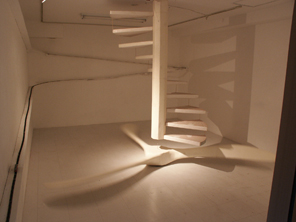イントロダクション
出月秀明:世界とともにあるために
岡部あおみ(αMプロジェクト2005キュレーター)
恐竜の骨のような白い階段が天井からスパイラルに降り、プロペラが床面近くでゆっくり回っている。規則的な回転速度が、官能的でもある降下と上昇の身体運動を空想させる。観客は展示室を占有する巨大なプロペラの周期に呼吸をあわせて、ぶつからないように歩かねばならない。壁面には山の斜面を往復するおもちゃの電車の線路が敷かれ、小粒な電車の軌跡が遠く懐かしい風景を蘇らせる。
2004年に体験した出月秀明のインスタレーションは、異空間から流れ込む空気の肌合いとゆったりとした彼方からの時間の訪れに心を奪われた。その3年前に、二機のプロペラと楕円の線路を使ったインスタレーションを、出月はシュトゥットガルトで制作し、ドクメンタではじめて女性の芸術監督となったカトリーヌ・ダヴィッドを魅了していた。出月秀明との出会いは、珍しくもこのダヴィッドによる仲介であった。
少年時代からさまざまな土地に「移住」し、その「周囲」を回り、最北端などの「端」まで歩いたという。2000年、26歳のときにアイルランドの西端にあるアラン諸島のイニシュマーン島を徒歩で一周したのも、人間が生きる土地をつねに求める彼の自然な歩みの軌跡のためだ。そして出会ったのが、素敵な手編みの毛糸の帽子。「虹のかけら」と呼ぶその帽子を友人や恩師にプレゼントし、それを被って会議を開くことを計画した。
今回の個展は、すでに2回開かれている『アランの毛糸帽子会議』の第3回目。クリスマスも間近な京橋のギャラリーに暖炉が現れる。出月秀明のたっての願いで、建築家でデザイナーの中村好文が、ソフトな触感の椅子や机などの家具とともに、かっこいい暖炉型ストーヴを特別出品してくれることになった。偶然だが、中村好文もアラン諸島に旅をしている。そういえば、詩人で小説家の富岡多恵子もアランの旅人だった。『セーターからジョイスへ』という短編小説に、手編みのアラン・セーターの話が登場する。富岡によれば、伝説のセーターはかつて海の男に捧げるために女たちが編み、その編み方で男を特定できたらしい。
アイルランドの荒涼とした景色には、いうにいえない淋しさの原野を感じる。出月秀明は、2003年に青森で二つの映像を作った。有名な大間崎のマグロ漁の漁船に乗った『最後の土地』と雪山のマタギを描いた『魔の山』で、ともに生死を分かつ境界で、厳しい自然と向き合う孤独な人間の内面世界をとりあげている。『アランの毛糸帽子会議』も、都会で見捨てられている周縁的で原始的な火を囲むといった人との触れ合いの場を通して、日常を異化し、本来の感性の回復をめざしている。
異国の見知らぬ街路で、その町を案内してくれる人を求めるビラをくばり、何日もたちつづけるイベントも行った。新たな出会いのために異邦人が積み重ねねばならない徒労に満ちた努力と、少しの勇気さえあれば退屈な日常を変えられるはずの住民たちの無関心、真摯でひたむきな出月の姿が胸を打つ。歩き、作り、留まり、語り合うという繊細でなにげない行為の連鎖を、彼は世界の編物のように続けている。

Musee F 表参道ギャラリー個展・東京2004
photo:Tomomi Ozawa
*下記のαMプロジェクトのサイトで 出月秀明の作品を見られます。
http://www.musabi.ac.jp/ampj/2005/06idetsuki/index.htm
Hideaki Idetsuki: To Be with the World
Aomi Okabe, α M Project 2005 curator
A white staircase like a dinosaur's bones spirals down from the ceiling and a propeller turns slowly near the floor. The regular speed of rotation calls up thoughts of a sensual up and down movement of the body. Visitors must adjust themselves to the cycle of the propeller that dominates the gallery space, walking carefully to avoid hitting it. On the wall surface is a track for a model train that shuttles back and forth on the side of a mountain. The movements of the little train arouse memories of a faraway, nostalgic landscape.
When I experienced this installation by Hideaki Idetsuki in 2004, I was fascinated by the texture of the atmosphere, flowing in from a different kind of space, and the slow arrival of time from somewhere far away. Three years before that, Idetsuki made an installation in Stuttgart using two propellers and an oval track. This work impressed Catherine David, the first woman to serve as artistic director of "Documenta", and strangely enough, I met Idetsuki through Ms. David.
He says that since childhood he has "moved" from place to place, traveled around "perimeters," and walked to the farthest northern "edges." In 2000, at age 26, he walked around Meain Island, one of the Aran Islands. This was a way of tracing his pattern of walking naturally in a continuing search for lands where people live. There he found beautiful knit caps. He made gifts of these hats, known as "pieces of the rainbow," to friends and teachers, and he has decided to hold a conference with people wearing these hats.
The current solo exhibition is the third in the series, "Aran Knit Hat Conference." Christmas is near and there will also be a stove-fireplace in the gallery in Kyobashi. Idetsuki has asked architect and designer Yoshifumi Nakamura to exhibit a stove and furniture, including soft chairs and a table, of his own design. By a strange coincidence, Nakamura has also traveled in the Aran Islands. So has poet and novelist Taeko Tomioka. She writes about hand-made Aran sweaters in a short novel, From Sweaters to Joyce. According to Tomioka, these legendary sweaters were once knit by women to give to seamen, and it was possible to identify the man by the knit pattern of his sweater.
The bleak scenery of the Aran Islands conveys an ineffable sense of loneliness. Idetsuki made two films in Aomori in 2003, Last Land, about a fishing boat fishing for tuna out of Omazaki, and Magic Mountain, which depicts a bear hunter in snowy mountains. Both films deal with the inner life of solitary men who confront the fiercest.
(translated by Stanley N. Anderson)
*There are more photos of Hideaki Idestuki art works :
http://www.musabi.ac.jp/ampj/2005/06idetsuki/index.htm

